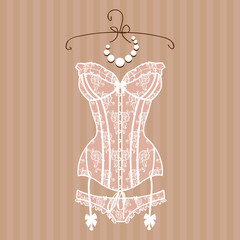 A few years ago when I was sorting through my 96-year-old mother’s things for her move into a rest home, there was one garment that I just couldn’t throw out – her corsets.
A few years ago when I was sorting through my 96-year-old mother’s things for her move into a rest home, there was one garment that I just couldn’t throw out – her corsets.
It brought back so many memories of my mother’s obsession with “good foundation garments” and the laughter while shoe-horning her into some of the earlier models which were heavy duty pieces of engineering with steel bones, rows of hooks and serious reinforcements.
While nowadays we pop into a shop in our lunch hour to try on a dress or skirt, shopping for clothes was never impromptu for my mother – especially in the 60s and 70s. “I’ll try it on at home with my good corsets,” she’d whisper confidentially to the black-clad shop assistant and we’d leave the Farmers Co-op laden down with brown paper packages tied with string – all “on appro.”
I remember when she was all trussed up in her best, hugging her was like embracing a telegraph pole. I remember too on a hot summer’s day how she’d long for any visitors to leave so she could get out of the corset, which left big red welts on her white skin.
Right up until the late 90s when she was in her late 80s, even though she was a shadow of her former buxom self, my mother insisted on regular fittings for a new corset and never felt completely dressed without it.
Christine Brady, who is the owner of Auckland’s two Naturalwear shops – in Onehunga and Milford, was has trained to be a corsetiere back in 1986 with the well-known Pat Jennings in Melbourne. When she first started in the industry, many of her clients for corsetry fittings were like my mother – elderly women who had grown up in foundation garments.
Christine still has a demand (“mostly for larger women”) for the all-in-one pants and bra combination style that I have as a keepsake. “It used to be that you had to lie on a bed to hook it up, it’s still a body suit but in much softer material,” she explains. But, it’s the more flexible natural control underwear – like the Bum, Tum and Thigh Reducer marketed by Trinny and Susannah, which are now selling well to women of all age groups.
“These garments are enormously popular here,” says Christine. While the mid to late 90s saw a big downturn in the sale of corsets and panty girdles, the advent of the new body shapers in fabric that is more pliable but has more strength has been a real success story. Many versions of these garments are now on sale here – some with an extended extended waistband that ends just under the bra, incorporating those problem areas around the waist a.k.a. the “muffin top”.
“These garments support a painful back, equalize the tummy and spread everything out evenly for a smooth look – especially if you are wearing a dress in an unforgiving fabric. They feel firm and very comfy,” Christine explains. “Lingerie has changed over the years, it’s now much softer and feminine.”
Some women are still looking for a bit of firm control but without the necessity of the smelling salts they had on hand in the Victorian times because they were so tightly laced there was always a danger of fainting or the acute discomfort of the rubber corset of the 1930s.
The newly developed fabrics (many also have non-cling properties) are also featured in the new natural-look bras. “The smooth-cup t-shirt bras are very popular,” she adds. And for those amongst us who are not naturally well endowed, there are the trusty padded bras for instant cleavage, but Christine stresses the importance of a “fitting with a trained corsetiere.”
My dear old mother would agree with that.
Article by Robyn Yousef, Courtesy of My Generation.









Join the Discussion
Type out your comment here:
You must be logged in to post a comment.